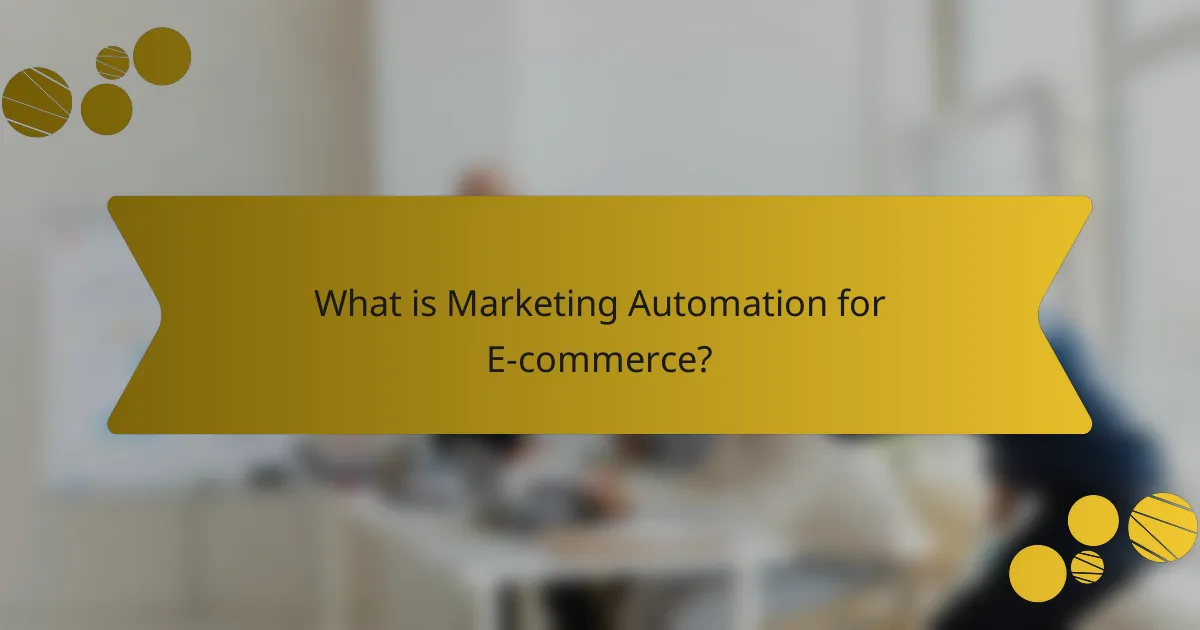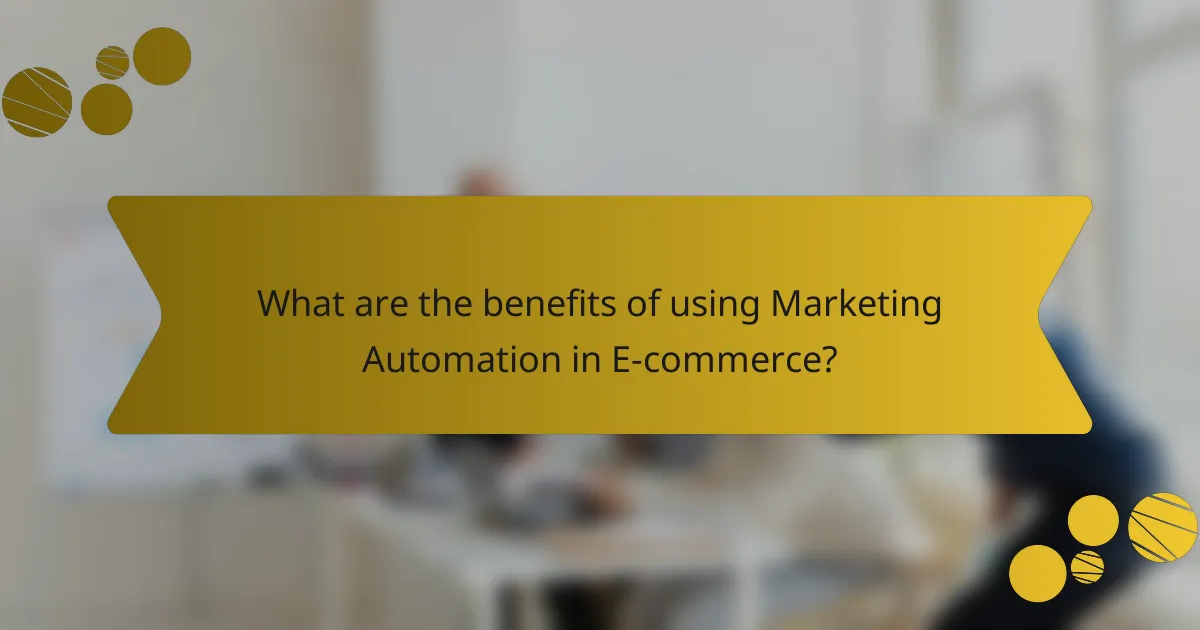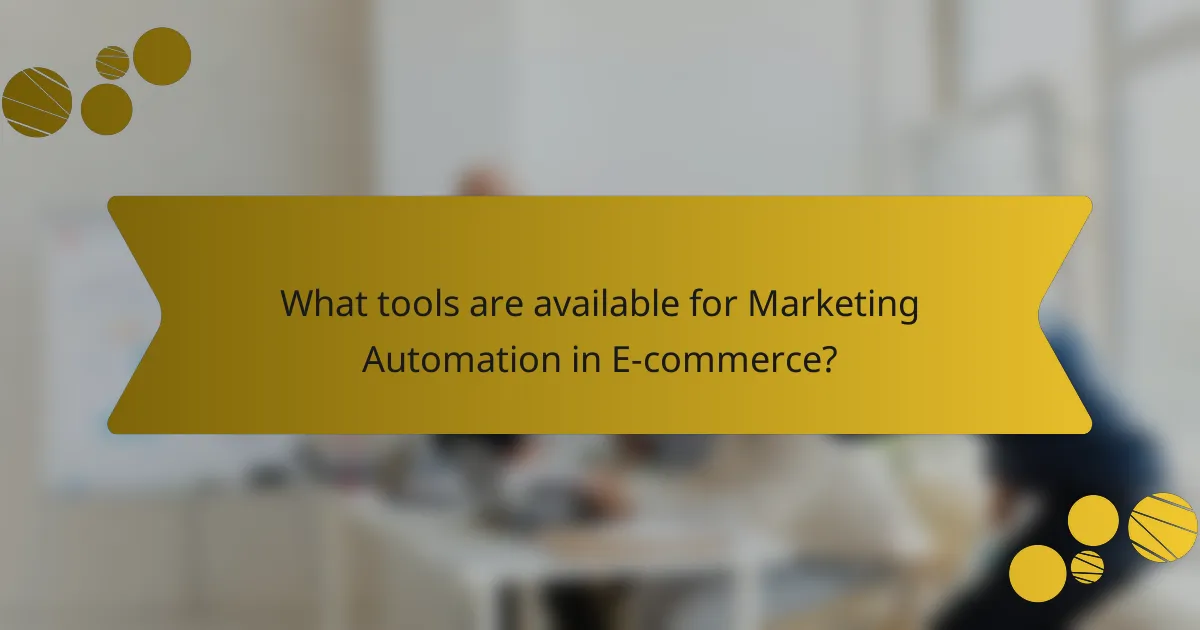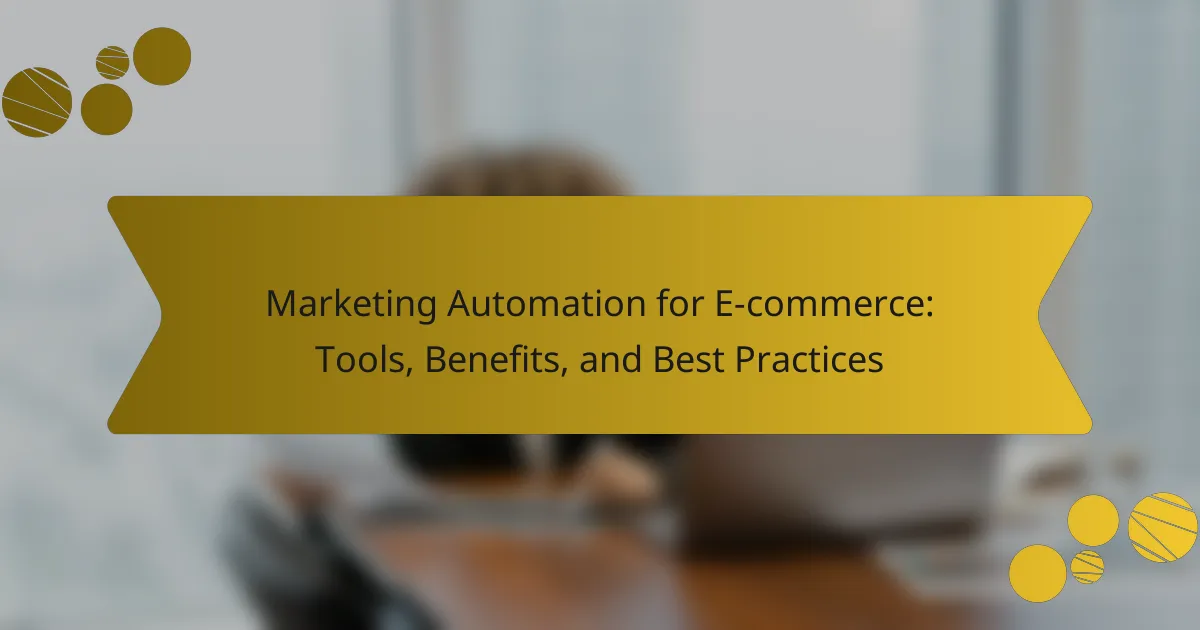Marketing automation for e-commerce involves using software to automate marketing tasks and workflows, enhancing efficiency and driving sales growth. This technology streamlines processes such as email marketing, social media posting, and advertising, allowing businesses to target customers based on their behavior and preferences. Key benefits include increased productivity, personalized customer experiences, and valuable analytics for data-driven decision-making. Notable marketing automation tools for e-commerce include HubSpot, Mailchimp, and Klaviyo, each offering unique features to improve customer engagement and sales performance. The article will explore these tools, their benefits, and best practices for effective implementation in e-commerce marketing strategies.

What is Marketing Automation for E-commerce?
Marketing automation for e-commerce refers to the use of software to automate marketing tasks and workflows. This technology streamlines processes such as email marketing, social media posting, and ad campaigns. It enables businesses to target customers more effectively based on their behavior and preferences. By automating repetitive tasks, e-commerce companies can save time and reduce human error. Marketing automation can also enhance customer engagement through personalized communication. According to a report by HubSpot, 70% of marketers say that automated emails are the best way to nurture leads. This indicates the effectiveness of automation in driving sales and customer loyalty.
How does Marketing Automation enhance E-commerce operations?
Marketing automation enhances e-commerce operations by streamlining processes and improving customer engagement. It allows businesses to automate repetitive tasks such as email marketing, social media posting, and ad campaigns. This automation saves time and reduces human error.
According to a study by HubSpot, companies that use marketing automation see a 14.5% increase in sales productivity. Automation tools can segment audiences, allowing for personalized marketing strategies. Personalized communication leads to higher conversion rates.
Furthermore, marketing automation provides valuable analytics. These insights help businesses understand customer behavior and optimize marketing strategies. Overall, marketing automation significantly boosts efficiency and effectiveness in e-commerce operations.
What are the key features of Marketing Automation tools?
Key features of Marketing Automation tools include email marketing, lead scoring, and customer segmentation. Email marketing allows businesses to send targeted campaigns based on user behavior. Lead scoring helps prioritize leads based on their engagement and likelihood to convert. Customer segmentation enables marketers to tailor messages to specific audience groups. Additionally, automation tools often provide analytics and reporting features. These features allow businesses to measure campaign performance and optimize strategies. Integrating CRM systems is another common feature. This integration ensures a seamless flow of customer data for more personalized marketing efforts.
How do these features integrate with E-commerce platforms?
Marketing automation features integrate with e-commerce platforms by streamlining processes and enhancing customer engagement. These features enable automated email campaigns, personalized product recommendations, and targeted promotions. Integration occurs through APIs that connect marketing tools with e-commerce systems. This allows for real-time data sharing, such as customer behavior and purchase history. For example, platforms like Shopify and WooCommerce offer plugins that facilitate this integration. The result is improved customer experiences and increased sales conversions. Studies show that businesses utilizing marketing automation see a 14.5% increase in sales productivity.
Why is Marketing Automation important for E-commerce businesses?
Marketing automation is important for e-commerce businesses because it streamlines marketing efforts and enhances customer engagement. It allows businesses to automate repetitive tasks, such as email campaigns and social media posting. This leads to increased efficiency and allows teams to focus on strategy and creativity. According to a study by Nucleus Research, marketing automation can increase sales productivity by up to 14.5%. Additionally, it enables personalized marketing, which can improve customer satisfaction and retention rates. Businesses that use marketing automation experience a 451% increase in qualified leads, according to the Annuitas Group. Overall, marketing automation is a crucial tool for driving growth and improving customer relationships in the e-commerce sector.
What challenges do E-commerce businesses face without Marketing Automation?
E-commerce businesses face significant challenges without marketing automation. Manual marketing processes lead to inefficiencies in campaign management. This can result in missed opportunities for timely customer engagement. Additionally, without automation, businesses struggle to segment their audience effectively. This limits their ability to personalize marketing messages. As a result, conversion rates can decline. Data analysis becomes cumbersome and time-consuming without automated tools. This hinders businesses from making informed decisions based on customer behavior. Overall, the absence of marketing automation can stifle growth and competitiveness in the e-commerce landscape.
How can Marketing Automation improve customer engagement?
Marketing automation improves customer engagement by personalizing communication and streamlining interactions. It enables businesses to send targeted messages based on customer behavior. For example, automated emails can be triggered by specific actions, such as cart abandonment. This timely communication can increase conversion rates by up to 20%.
Additionally, marketing automation allows for segmentation of audiences. Businesses can categorize customers based on their preferences and purchasing history. This ensures that customers receive relevant content, enhancing their overall experience.
Furthermore, automation tools provide analytics and insights into customer behavior. This data helps businesses refine their strategies and improve engagement over time. According to a report by HubSpot, companies that use marketing automation see a 451% increase in qualified leads.
In summary, marketing automation enhances customer engagement through personalization, targeted communication, audience segmentation, and actionable insights.

What are the benefits of using Marketing Automation in E-commerce?
Marketing automation in e-commerce enhances efficiency and drives sales growth. It streamlines repetitive tasks such as email marketing and social media posting. This leads to increased productivity for marketing teams. Automation allows for personalized customer experiences through targeted campaigns. According to a study by Nucleus Research, businesses using marketing automation see a 14.5% increase in sales productivity. Additionally, it provides valuable analytics and insights, enabling data-driven decisions. Automation helps in nurturing leads effectively, converting them into loyal customers. Overall, these benefits contribute to higher return on investment in marketing efforts.
How does Marketing Automation increase sales and revenue?
Marketing automation increases sales and revenue by streamlining marketing processes and enhancing customer engagement. It allows businesses to automate repetitive tasks, such as email campaigns and social media postings. This automation leads to increased efficiency and consistency in messaging.
Furthermore, marketing automation provides valuable insights through data analytics. Businesses can track customer behavior and preferences. This data enables targeted marketing strategies that resonate with specific audiences.
According to a study by HubSpot, companies using marketing automation see a 451% increase in qualified leads. Additionally, 80% of marketers report that automation helps them generate more leads. These statistics validate the positive impact of marketing automation on sales and revenue growth.
What role does personalized marketing play in sales growth?
Personalized marketing significantly boosts sales growth by tailoring messages and offers to individual customer preferences. This approach enhances customer engagement and improves conversion rates. According to a study by Epsilon, 80% of consumers are more likely to make a purchase when brands offer personalized experiences. Additionally, businesses that implement personalization strategies can see revenue increases of up to 15%. Personalized marketing fosters customer loyalty by making customers feel valued and understood. This leads to repeat purchases and higher customer lifetime value. Overall, personalized marketing plays a crucial role in driving sales growth through targeted communication and enhanced customer relationships.
How can automation reduce cart abandonment rates?
Automation can significantly reduce cart abandonment rates by streamlining communication and enhancing user experience. Automated email reminders can prompt customers to complete their purchases. Research indicates that sending a cart abandonment email can recover up to 20% of lost sales. Personalized messages can increase engagement and conversion rates. Automation can also simplify the checkout process, reducing friction for users. Features like saved carts and one-click purchasing enhance convenience. Furthermore, automated retargeting ads can re-engage visitors who left without buying. These strategies collectively lead to lower abandonment rates and increased revenue.
What cost savings can be achieved through Marketing Automation?
Marketing automation can lead to significant cost savings for businesses. It reduces manual labor by automating repetitive tasks such as email marketing, social media posting, and lead generation. According to a study by the Aberdeen Group, companies using marketing automation experience a 14.5% increase in sales productivity and a 12.2% reduction in marketing overhead.
Additionally, marketing automation allows for better targeting and segmentation of audiences. This precision leads to higher conversion rates and more efficient spending on marketing campaigns. A report from HubSpot indicates that businesses using marketing automation can save up to 20% on their overall marketing costs.
Furthermore, by streamlining processes, companies can allocate resources more effectively. This means less time and money wasted on ineffective marketing strategies. In conclusion, the integration of marketing automation can yield substantial financial benefits through efficiency and improved marketing performance.
How does Marketing Automation optimize marketing budgets?
Marketing automation optimizes marketing budgets by streamlining processes and improving targeting. It reduces manual labor, allowing teams to focus on strategy. Automated tools can analyze customer data to identify high-value segments. This targeted approach increases conversion rates and reduces wasted ad spend. According to a study by HubSpot, businesses using marketing automation see a 14.5% increase in sales productivity. Additionally, marketing automation can lead to a 12.2% reduction in marketing overhead. These efficiencies contribute to better budget allocation and overall cost savings.
What are the long-term financial benefits for E-commerce businesses?
E-commerce businesses can experience significant long-term financial benefits. These benefits include reduced operational costs, increased sales, and improved customer retention. Automation tools streamline processes, lowering labor expenses. According to a study by McKinsey, companies that automate can reduce operational costs by up to 30%. Enhanced sales come from targeted marketing strategies, which can increase conversion rates. Research from HubSpot indicates that personalized marketing can boost sales by 20%. Additionally, automated customer engagement fosters loyalty, leading to repeat purchases. Data shows that retaining existing customers is five times cheaper than acquiring new ones. Overall, these factors contribute to sustained profitability for e-commerce businesses.

What tools are available for Marketing Automation in E-commerce?
Marketing automation tools available for e-commerce include platforms like HubSpot, Mailchimp, and Klaviyo. HubSpot offers comprehensive CRM and marketing automation features tailored for e-commerce. Mailchimp specializes in email marketing automation, providing tools for customer segmentation and campaign tracking. Klaviyo focuses on personalized email marketing and integrates seamlessly with various e-commerce platforms. Other notable tools are ActiveCampaign, which combines email marketing with automation workflows, and Shopify’s built-in marketing tools that facilitate promotional campaigns. These tools help streamline marketing efforts, enhance customer engagement, and drive sales growth.
What are the most popular Marketing Automation tools for E-commerce?
The most popular Marketing Automation tools for E-commerce include HubSpot, Mailchimp, Klaviyo, ActiveCampaign, and Omnisend. HubSpot offers a comprehensive suite for managing customer relationships and automating marketing tasks. Mailchimp is known for its user-friendly interface and robust email marketing features. Klaviyo specializes in personalized email marketing and customer segmentation. ActiveCampaign combines email marketing with CRM capabilities for effective automation. Omnisend focuses on multi-channel marketing automation tailored for E-commerce businesses. These tools are widely recognized for their effectiveness in enhancing marketing strategies and improving customer engagement.
How do these tools compare in terms of features and pricing?
The comparison of marketing automation tools for e-commerce reveals distinct differences in features and pricing. Tools such as HubSpot, Mailchimp, and Klaviyo offer various functionalities tailored for e-commerce. HubSpot provides comprehensive CRM capabilities, advanced analytics, and email marketing solutions, starting at $50 per month. Mailchimp focuses on user-friendly email marketing and automation features, with pricing beginning at $10 per month. Klaviyo specializes in targeted email campaigns and customer segmentation, with plans starting at $20 per month based on the number of contacts. Each tool has unique attributes that cater to different business needs. For example, HubSpot’s extensive integration options make it ideal for larger enterprises. In contrast, Mailchimp’s affordability appeals to small businesses. Klaviyo’s robust data analytics is beneficial for data-driven marketing strategies. Overall, the choice among these tools should consider both specific features and budget constraints.
What unique attributes do specific tools offer to E-commerce businesses?
Specific tools for E-commerce businesses offer unique attributes such as advanced analytics, automation capabilities, and personalized customer experiences. Advanced analytics provide insights into customer behavior and sales trends. This data-driven approach helps businesses make informed decisions. Automation capabilities streamline repetitive tasks like email marketing and inventory management. This efficiency saves time and reduces human error. Personalized customer experiences are facilitated through segmentation and targeted messaging. Tools can tailor recommendations based on user behavior. These unique attributes enhance customer engagement and drive conversions. For instance, a study by McKinsey found that personalized marketing can lead to a 10-30% increase in revenue.
How can businesses choose the right Marketing Automation tool?
Businesses can choose the right Marketing Automation tool by assessing their specific needs and goals. They should first identify the features that align with their marketing strategy. Key features include email marketing, customer segmentation, and analytics capabilities. Next, businesses should evaluate the user interface for ease of use. A tool with a steep learning curve may hinder adoption. Budget is another crucial factor; businesses should consider both upfront costs and long-term ROI. Integration with existing systems is essential for seamless operations. Researching customer reviews and case studies can provide insights into real-world effectiveness. Finally, many vendors offer trial periods, allowing businesses to test functionality before commitment.
What factors should be considered when selecting a tool?
When selecting a tool for marketing automation in e-commerce, consider functionality, ease of use, integration capabilities, and cost. Functionality should align with specific marketing needs, such as email campaigns or customer segmentation. Ease of use impacts team adoption and efficiency. Integration capabilities with existing systems ensure seamless data flow. Cost should fit the budget while providing value. Research shows that 70% of e-commerce businesses prioritize integration features when choosing automation tools.
How can businesses evaluate the effectiveness of their chosen tool?
Businesses can evaluate the effectiveness of their chosen tool by measuring key performance indicators (KPIs) relevant to their objectives. These KPIs may include conversion rates, customer engagement metrics, and return on investment (ROI). Analyzing these metrics helps in understanding the tool’s impact on sales and customer satisfaction. Businesses should also gather feedback from users to assess usability and functionality. Conducting A/B testing can provide insights into the tool’s performance compared to alternatives. Tracking the time saved on marketing tasks can indicate efficiency improvements. Regularly reviewing these evaluations ensures that the tool continues to meet business needs effectively.
What best practices should be followed when implementing Marketing Automation?
Implementing marketing automation effectively requires following several best practices. First, define clear goals for your automation strategy. Establish what you aim to achieve, such as increased sales or improved customer engagement. Next, segment your audience based on behavior and preferences. This ensures personalized messaging that resonates with each group.
Additionally, choose the right tools that align with your business needs. Consider features like analytics, integrations, and user-friendliness. Implement a comprehensive content strategy that includes relevant and engaging materials for your audience. Regularly test and optimize your campaigns based on performance metrics. This data-driven approach enhances effectiveness.
Furthermore, ensure compliance with data protection regulations. Protect customer data and maintain transparency in your practices. Finally, provide training for your team on the chosen tools and strategies. A knowledgeable team maximizes the benefits of marketing automation. These practices lead to successful implementation and improved marketing outcomes.
How can businesses ensure successful onboarding of Marketing Automation tools?
Businesses can ensure successful onboarding of Marketing Automation tools by implementing a structured plan. This plan should include clear objectives and goals for the automation process. Training sessions for staff are essential to familiarize them with the tool’s functionalities. Providing access to comprehensive resources and documentation can enhance understanding. Regular check-ins during the onboarding process help address any challenges quickly. Feedback mechanisms should be established to gather insights from users. According to research by HubSpot, companies that invest in training see a 20% increase in user adoption rates. This structured approach leads to smoother integration and maximizes the tool’s effectiveness.
What strategies can enhance the effectiveness of Marketing Automation campaigns?
Personalization enhances the effectiveness of Marketing Automation campaigns. Tailoring messages to individual customer preferences increases engagement rates. According to a study by Epsilon, 80% of consumers are more likely to make a purchase when brands offer personalized experiences. Segmenting your audience based on behavior and demographics allows for targeted messaging. Automated follow-ups after customer interactions also drive higher conversion rates. Research shows that automated emails have a 119% higher click rate than broadcast emails. Testing and optimizing campaign elements, such as subject lines and send times, further improve outcomes. Data-driven decision-making ensures strategies align with customer needs and market trends.
Marketing automation for e-commerce is the use of software to automate marketing tasks and workflows, enhancing efficiency and customer engagement. This article covers the key features of marketing automation tools, their integration with e-commerce platforms, and the benefits they provide, such as increased sales productivity and personalized marketing strategies. Additionally, it addresses the challenges e-commerce businesses face without automation, the cost savings achieved, and best practices for successful implementation. The article also evaluates popular marketing automation tools and offers strategies to enhance campaign effectiveness, providing a comprehensive overview of how these tools drive growth in the e-commerce sector.
